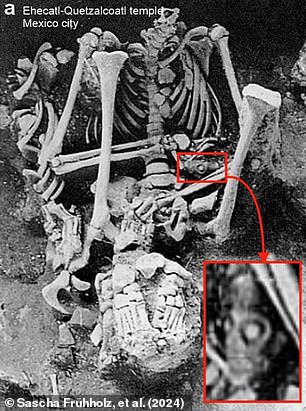Listen to the ‘scariest sound in the world’: the ancient Aztec death whistle that sounds like the ‘scream of 1,000 corpses’ STILL scares people to this day, research shows
The wail of the Aztec Death Flute was the last thing many human sacrifices ever heard before meeting their untimely end.
The chilling sound has been described as the ‘scariest sound in the world’ and lies somewhere between a ghostly whistling wind and ‘the scream of a thousand corpses’.
Research has shown that this instrument is just as terrifying to people today as it was 500 years ago.
Scientists from the University of Zurich played the sound of the Aztec Death Flute to a group of volunteers and recorded how their brains responded.
Participants who heard it reported feeling scared, while the brain scans showed that the sound puts the listener on high alert and activates neural areas linked to core emotions such as anger, fear and sadness.
Researchers believe the whistles may have been used to frighten victims and onlookers during human sacrifice rituals.
Lead author Professor Sascha Frühholz told MailOnline: ‘The sound is rough and high-pitched, and as listeners you usually don’t like such sounds.’
So, are you brave enough to listen to it?

Aztec Death Flutes are clay instruments typically shaped like skulls found on graves of victims of ritual sacrifice, dated between 1250 and 1521 AD.
Aztec Death Flutes, or Skull Flutes, are a type of unusual musical instrument found at grave sites from the period 1250 to 1521 AD.
Their unusual skull-like shape baffled archaeologists for years, until one brave researcher decided to blow into the opening at the top of an artifact.
When played with force, the resulting sound was a cacophonous, piercing wail reminiscent of human screams.
Archaeologists are not yet sure what these unusual instruments were used for, but some suggest they may have been used to frighten the enemy during battles or as part of human sacrifice rituals.
To find out more, the researchers decided to test how modern listeners unfamiliar with the Aztec Death Whistle would respond to the sound.
Professor Frühholz said: ‘Since the Aztec skull whistle sounds close to a human scream, we wanted to investigate whether humans have the same negative and aversive response to the Aztec death whistle sounds.’
A group of European participants heard recordings of real Aztec Death Flutes, replicas and whistles of the researcher’s own creation, along with a range of other recorded sounds.
Participants were then asked to describe what they heard and how it made them feel, while their brain activation was recorded by functional magnetic resonance imaging (fMRI).
Almost universally, the sound caused a strong negative emotional response, as well as a sense of urgency and excitement.
In terms of its effect on the listener, the Death Whistle was most similar to firearms, sirens, angry voices and cries of pain or fear.
The researchers suggest that the Aztec Death Whistle may have been built to mimic natural sounds such as screams and reproduce the effect this has on the listener.
Previous studies have shown that the death whistle works by producing multiple tones simultaneously as air collides in the different chambers.
By analyzing the acoustic profile of different whistles, the researchers found that the resulting “noisy and rough” sound profile contains effects commonly found in primate screams and “terrifying music.”
The fear factor is made even more intense by incorporating tones commonly found in human speech and shouting.
However, the researchers noticed another interesting detail in the listeners’ responses.
In addition to having to say how the sound made them feel, each participant was also asked to come up with a description of the sound.

Participants who heard the Aztez Death Whistle (highlighted in red as SW) reported experiencing high levels of negative emotions (valence), strong emotional arousal, and an intense sense of urgency
A human scream was the most common comparison.
However, participants also referred to a number of artificial sounds such as boilers, chainsaws, trains or machines.
In their article, published in Communication psychologythe researchers suggest that this unusual mix of natural and unnatural could be part of the reason why the Aztec Death Flute is so scary.
Professor Frühholz says: ‘With fMRI we have discovered that the sounds have both an affective (emotional) character and a more abstract and symbolic character, triggering associative mechanisms in the brain.’
When a listener heard the Death Whistle, it caused a surge of activity in the auditory processing areas of the brain as they tried to determine the origin of the sound.
This sudden activation tended to confuse the brain, leaving it temporarily bewildered and confused.
The Aztecs may have exploited this shocking impact as a way to instill fear in the public.
However, archaeologists are still unsure whether that audience was intended as an approaching enemy army or as a group of worshipers in a cult of human sacrifice.

Researchers have discovered that the haunting sound of the Aztec Death Flute (pictured) is as terrifying to modern listeners as it was to the Aztecs more than 500 years ago.
Because the sound is so frightening, it could be that the Death Flute was used in warfare, but Professor Frühholz and his co-authors believe the ritual explanation is more likely.
Aztec Death Flutes have been found in the hands of victims of ritual sacrifices in temples such as the Ehecatl-Quetzalcoatl Temple in Mexico City.
Likewise, the skull statues synonymous with the Aztec Death Flute could depict Mictlantecuhtli, the Aztec Lord of the Underworld.
In their article, Professor Frühholz and his co-authors write: ‘Given both the aversive/engaging and the associative/symbolic sound nature and the currently known excavation sites at ritual cemeteries with human sacrifices, use in ritual contexts seems very likely, especially in sacrificial rituals and ceremonies that related to the dead.
‘Skull whistles may have been used to frighten the human sacrifice or ceremonial audience, but further cross-documentation is needed here.’
